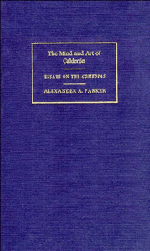Book contents
- Frontmatter
- Contents
- Author's preface
- Editor's preface
- Introduction
- I Stylistic and dramatic craftsmanship
- II From experience to myth
- 6 The father–son conflict
- 7 Segismundo's tower: a Calderonian myth
- 8 Horoscopes and their fulfilment
- 9 Fate and human responsibility (1): the problem
- 10 Fate and human responsibility (2): a dramatic presentation – El mayor monstruo los celos
- III The tensions of social life
- IV The tensions of public life
- V From symbol to myth
- Epilogue
- Notes
- Index
10 - Fate and human responsibility (2): a dramatic presentation – El mayor monstruo los celos
Published online by Cambridge University Press: 05 February 2012
- Frontmatter
- Contents
- Author's preface
- Editor's preface
- Introduction
- I Stylistic and dramatic craftsmanship
- II From experience to myth
- 6 The father–son conflict
- 7 Segismundo's tower: a Calderonian myth
- 8 Horoscopes and their fulfilment
- 9 Fate and human responsibility (1): the problem
- 10 Fate and human responsibility (2): a dramatic presentation – El mayor monstruo los celos
- III The tensions of social life
- IV The tensions of public life
- V From symbol to myth
- Epilogue
- Notes
- Index
Summary
Tirso de Molina preceded Calderón in dramatising the story of Herod and Mariamne. Despite the great differences between the two plays, Blanca de los Ríos affirmed that Calderón owed much to La vida y muerte de Herodes. Since the plays have absolutely nothing in common, all that can be affirmed is that Tirso's play may have been the stimulus that made Calderón's mind turn to the Herod story. That he read Tirso's play is certain, for it was published in the latter's Quinta Parte de comedias (1636) for which Calderón wrote a respectful aprobación (censor's official approval). The composition of El mayor monstruo los celos could have followed this, for it was published in his Segunda Parte in 1637, though this does not leave much time for the play to have been performed, and for the text to have become corrupted before it reached the printer. Calderon later revised it and the revision was licensed for performance in 1667, and again in 1672; at the end it is stated that the play is
Como la escribió su autor;
no como la inprimió el urto,
de quien es su estudio echar
a perder otros estudios
(as the author wrote it; and not as it was printed by piracy, whose purpose is to spoil another's production)
There is nothing in the texts of the two plays to indicate that they are in any way dependent.
- Type
- Chapter
- Information
- The Mind and Art of CalderónEssays on the Comedias, pp. 114 - 130Publisher: Cambridge University PressPrint publication year: 1989



